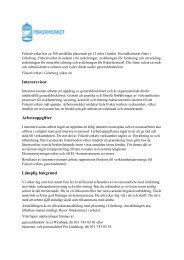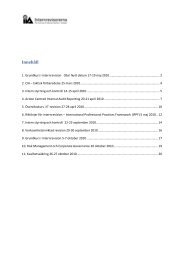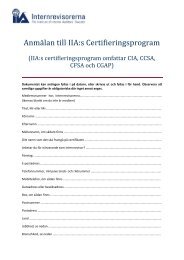#1/2011 - Internrevisorerna - Hem
#1/2011 - Internrevisorerna - Hem
#1/2011 - Internrevisorerna - Hem
Create successful ePaper yourself
Turn your PDF publications into a flip-book with our unique Google optimized e-Paper software.
BLENDED ENGAGEMENTS<br />
visory and related client service activities, the nature and<br />
scope of which are agreed with the client, are intended to add<br />
value and improve an organization’s governance, risk management,<br />
and control processes without the internal auditor<br />
assuming management responsibility. Examples include<br />
counsel, advice, facilitation, and training.»<br />
To add specificity the authors changed »related client service<br />
activities» to »facilitative and training activities,» rather<br />
than referring to them separately as examples. Moreover, the<br />
ILLUSTRATIVE BLENDED ENGAGEMENTS<br />
EXAMPLE ENGAGEMENTS<br />
Due diligence – Internal auditing<br />
provides assurance and<br />
consulting services in support<br />
of management's evaluation of<br />
an acquisition candidate<br />
System Development – Internal<br />
auditing provides assurance<br />
and consulting services during<br />
and after a significant system<br />
conversion project.<br />
Process Reengineering – Internal<br />
auditing provides assurance<br />
and consulting services<br />
during and after a process reengineering<br />
project.<br />
Risk Management – Internal<br />
auditing provides assurance<br />
and consulting services in support<br />
of the organization's risk<br />
management program.<br />
12 • INTERNREVISION 1/<strong>2011</strong><br />
EXAMPLE ASSURANCE COMPONENTS<br />
• Assess the adequacy of key controls in certain<br />
areas.<br />
• Assess the adequacy of documentation<br />
supporting management's control evaluations<br />
(e.g., Sarbanes-Oxley Section 404).<br />
• Assess the rigor of the risk management<br />
program<br />
• Determine whether other functions involved<br />
in the due diligence process have fulfilled<br />
their assigned responsibilities adequately and<br />
can support their conclusions<br />
• Determine whether the organization's<br />
prescribed system development process is<br />
followed throughout the project.<br />
• Assess whether user acceptence testing<br />
was sufficient and whether the testing results<br />
support management's decision tp move forward<br />
with the project.<br />
• Evaluate whether the new system, as implemented,<br />
achieves system objectives and<br />
meets users requirements.<br />
• Assess whether the process reengineering<br />
team adhered to management's proscribed<br />
reengineering policies and procedures.<br />
• Determine whether controls in the reengineered<br />
process are designed adequately.<br />
• Assess the adequacy of the existing risk<br />
management program against best practices.<br />
• Evaluate the completeness of the enterprise<br />
risk universe and reasonable of the risk ratings.<br />
• Assess whether the information provided by<br />
management to the board is accurate, relevant,<br />
and comprehensive.<br />
term counsel was removed to avoid redundancy with the<br />
word advice, and the word objective was added to emphasize<br />
that, like assurance services, consulting services must be<br />
conducted objectively. Lastly, the authors replaced client<br />
with customer because there are areas in the Standards and<br />
Practice Advisories where client generically refers to both assurance<br />
and consulting services — the authors prefer the use<br />
of a term that can be specifically associated with consulting<br />
services.<br />
EXAMPLE CONSULTING COMPONENTS<br />
Design an evaluation checklist that can be<br />
used vby other functions involved in evaluation<br />
the acquisition candidate.<br />
Facilitate management discussions regarding<br />
potential acquisition candidate evolution criteria.<br />
• Facilitate the process of defining user requirements.<br />
• Advise on system development best practices.<br />
• Train users on their system development<br />
roles and responsibilities.<br />
• Advise on how to conduct an effective and<br />
efficient process reengineering project.<br />
• Train key individuals involved in the project<br />
on steps to perform, analyses techniques,<br />
and documentation requirements.<br />
• Advise on specific procedures that will enhance<br />
the design of the process.<br />
• Facilitate the annual risk assessment process.<br />
• Advise on difference strategies that may be<br />
used to manage key risks.<br />
• Train risk owners on their risk management<br />
responsibilities.<br />
• Advise management on the steps necessary<br />
to initiate an enterprise risk management<br />
program.







